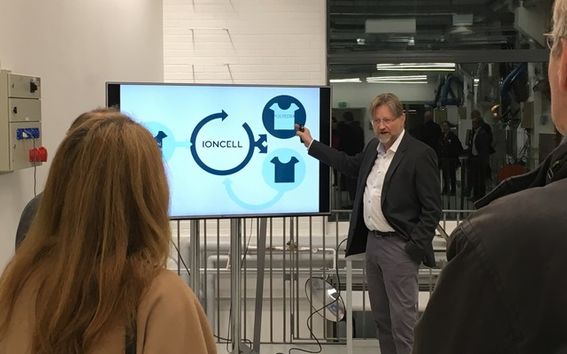Representatives of Important actor in Nordic research cooperation visit Aalto Bioproduct Centre

NOS-N, the Joint Committee of the Nordic Natural Science Research Councils, is a cooperation body comprised of Nordic organisations that finance research in the natural sciences and engineering. It is a key developer and coordinator of Nordic cooperation in research. Representatives of NOS-N visited Finland at the end of November.
Numerous projects jointly funded by the Nordic countries have been launched as a result of the committee's activities. In recent years, NOS-N has focused on topical matters related to its research infrastructures.
NOS-N members include the Swedish Research Council (Sweden), the Danish Agency for Science, Technology and Innovation, the Research Council of Norway, Rannis (Iceland), NordForsk and the Academy of Finland. Finnish actors, who take part in NOS-N's activities, include the director of the Academy of Finland Natural Sciences and Engineering Research Unit, as well as the chairman of its Research Council for Natural Sciences and Engineering. Finland will act as chair of NOS-N from autumn 2017 to autumn 2019.
During their visit to Finland, NOS-N representatives were invited to tour Aalto Bioproduct Centre, which opened in Otaniemi in May 2017. It is a research centre that combines top-quality bioeconomy research and teaching with corporate collaboration.
Aalto Bioproduct Centre, ABio, provides for example the facilities for the research and development of the Ioncell-F fibre production technology. In the research project headed by Professor Herbert Sixta, Ioncell-F technology is used to create textiles from cellulose fibres. This can be used to create new fabric from textile waste. In addition to Ioncell-F, Professor Sixta told the visitors about research related to nanocellulose, microcrystalline cellulose and wood building.
Jostein Sundet (left), NordForsk, Øyvind Pettersen, The Research Council of Norway, Susan Linko, the Academy of Finland and Mads de Wolff, Ministry of Higher Education and Science, Denmark, watch what happens when traditional ceramics techniques are applied to nanocellulose in an experimental CHEMARTS design project. Prof. Inga Berre from the University of Bergen, Prof.Michael Drewsen from Aarhus University and Prof. Lars Kloo from KTH Royal Institute of Technology in Stockholm took also part in the visit.
Professor Tapani Vuorinen told the visitors about the CHEMARTS project taking place at ABio, which combines biomaterials to the teaching and research of design. The visitors felt that the unique joint project between scientists and artists was exceptionally interesting.
ABio also houses the "factory of the future". Professor Sirkka-Liisa Jämsä-Jounela and the group's researchers Jukka Kortela, Babak Nasir and Antton Lahnalampi gave the visitors a presentation on the factory's process automation system. The "factory of the future" is a unique learning environment, which utilises 5G, cloud technology and virtualisation as well as technology provided by its partner ABB.
(Photos: Helena Seppälä)
Read more news

Get to know us: Associate Professor Maria Sammalkorpi
Sammalkorpi received her doctorate from Helsinki University of Technology 2004. After her defence, she has worked as a researcher at the Universities of Princeton, Yale and Aalto.
Aalto computer scientists in ICML 2024
Computer scientists in ICML 2024
Getting bacteria into line
Physicists use magnetic fields to manipulate bacterial behaviour